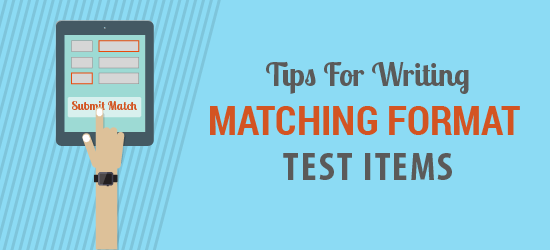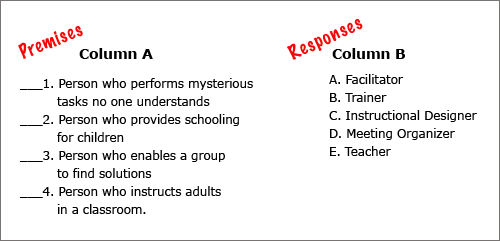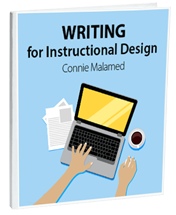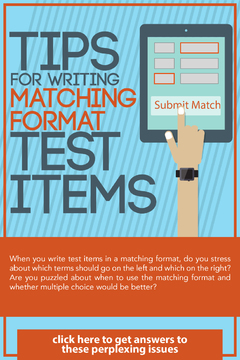

When you write matching type tests, do you stress about which terms should go on the left and which on the right? Are you puzzled about when to use the matching format and whether multiple choice would be better? Here are some answers to these perplexing issues.
The matching type test item format provides a way for learners to connect a word, sentence or phrase in one column to a corresponding word, sentence or phrase in a second column. The items in the first column are called premises and the answers in the second column are the responses. The convention is for learners to match the premise on the left with a given response on the right. By convention, the items in Column A are numbered and the items in Column B are labeled with capital letters.

Many authoring tools come with a pre-built matching type test template, which may involve dragging responses to the premise or typing the letters from Column B into Column A. The authoring tool templates may vary from the conventions of the written format.
The matching test item format provides a change of pace, particularly for self-check and review activities. Many instructional designers employ them in quizzes and tests too. They are effective when you need to measure the learner’s ability to identify the relationship or association between similar items. They work best when the course content has many parallel concepts, for example:
If you decide to use a matching type test, take the time to construct items that are valid and reliable. Here are some guidelines for this.
1. Two-part directions. Your clear directions at the start of each question need two parts: 1) how to make the match and 2) the basis for matching the response with the premise. You can also include whether items can be re-used, but often pre-built templates don’t allow for this.
Example for exercise above: Drag each career name in Column B to the best definition in Column A. No items may be used more than once.
2. Parallel content. Within one matching test item, use a common approach, such as all terms and definitions or all principles and the scenarios to which they apply.
3. Plausible answers. All responses in Column B should be plausible answers to the premises in Column A. Otherwise, the test loses some of its reliability because some answers will be “give-aways.”
4. Clueless. Ensure your premises don’t include hints through grammar (like implying the answer must be plural) or hints from word choice (like using the term itself in a definition).
5. Unequal responses. In an ideal world, you should present more responses than premises, so the remaining responses don’t work as hints to the correct answer. This is not often possible when using a template.
6. Limited premises. Due to the capacity limitations of working memory, avoid a long list of premises in the first column. A number that I’ve come across is to keep the list down to six items. Even less might be better, depending on the characteristics of your audience.
7. One correct answer. Every premise should have only one correct response. Obvious, but triple-check to make sure each response can only work for one premise.
You can find more guidelines for writing matching type tests at the University of Wisconsin’s Multiple Choice and Matching Test Guidelines. Also, listen to How to Plan, Design and Write Tests for an interview with a professor of psychometrics (the field of psychology that focuses on testing, measurement and assessment.)
The matching test item format has advantages. It allows you to cover more content in one question than you can with multiple choice. That’s why I think they are excellent for intermittent knowledge checks. They are also a very efficient approach to testing and can provide an excellent objective measurement. In addition, they provide a way to add some variety to your activities.
On the other hand, disadvantage of the matching type test is the tendency to use this format for the simple recall of information. Adult learners often require practice and testing of higher-order thinking skills, such as problem solving. Don’t limit your use of this format to recall of knowledge alone. Rather, try to find ways to use matching for application and analysis too, such as presenting a short scenario and asking for the best solution.
When using matching test items in an assessment, you’ll need to identify the specifics of how to score them. Some prefer to give partial credit when some—but not all—of the responses are correct. Often, the authoring tool determines the approach, but if you do have control, it’s an issue you’ll need to explore.
Did you like this article? Then don’t miss out on future issues! Sign up for The eLearning Coach Monthly Newsletter right now.
Related Articles and Podcast:

Get the latest articles, resources and freebies once a month plus my free eBook, Writing for Instructional Design. SEND EBOOK NOW

Hi Anthony – If I understand you correctly, are you asking whether it’s okay to create a matching type item, where responses match several premises? My personal opinion is that it’s okay if it provides an accurate assessment of the learner’s knowledge and it isn’t confusing to the learner. I haven’t seen any research on this though, so it’s just my opinion. Great question!
Connie
Connie, thanks for the article. I’ve been coming across this publication multiple times over the last 5 years, and it has great summary. This time I was looking for some specific thing, and it is a research for #7 recommendation. In some cases (I had many) it is good to have responses that match several premises. That’s ok because there are obviously several responses (+ maybe extra one in distractors). For example: we have a list of 6 software user scenarios, 3 of them are covered with one tool, 2 with another, and 1 is unique. Second and third have distractors, another distractor is random. Premises are reduced for the purpose, example is just made up: 1. Issues registration – A
2. Prioritization – A
3. Execution tracking – A
4. Code repository – B
5. Commits tracking and management – B
6. User Idea portal – C A – Jira
B – Git
C – Aha.io (and this one is tricky as it has tools for 1-3, but the aspect is very specific – the learner MUST know the difference)
D – Jenkins Of course there are other types of activities that can also be used (like three buckets and dragging items into them), but I believe that matching type of question is a perfect fit. That do you think?
I agree with you, Scott. This is a very poor design in so many ways. Some UX research suggests that designers should limit choices to 7 or less. In addition, being able to cross off a choice is cognitive aid. There is no way to hold the choices you’ve made in memory. The test flies in the face of good learning design and I would complain. Good luck. Let me know what happens if you do.
Connie
I’m currently taking a quiz which we have a week to work on in a college computer class. We have 69 matching terms with 69 definitions to match to the terms. It’s all done via drop down menu so crossing off answers used previously is not possible because you can’t even copy the drop down menu of answers. My question is, does 69 in one set of matching choices seem like a bit too many? Wouldn’t 7 sets of 10 be more applicable? At least it wouldn’t be as time consuming even if I have the whole week to do that and the other 30 multiple choice and 10 free form questions to do as well.
Hi Connie,
I’m sorry but it seems as if the answer would be dependent on so many variables (difficulty of question, complexity of the content, abilities of the student) that I have no idea what the answer is. Are you sure that this type of testing is the best approach? Perhaps students need sufficient time to think and reflect while taking a test and there should be some space in there. Perhaps critical thinking questions with essays would be better (I don’t know your topic).
Best,
Connie
Hi Sarma,
It does seem that logically it would work that way. You can send an example. The important thing is that the right answer is not a trick and that it can be interpreted easily.
Connie
In preparing matching type with one or more than one correct option type question, should the answer satisfy from col1 to col2 and col2 to col1 in both directions?